The Impact of Armed Conflict on Women and Girls - UNFPA
The Impact of Armed Conflict on Women and Girls - UNFPA
The Impact of Armed Conflict on Women and Girls - UNFPA
You also want an ePaper? Increase the reach of your titles
YUMPU automatically turns print PDFs into web optimized ePapers that Google loves.
community. It could destroy a victim’s relati<strong>on</strong> to both her family <strong>and</strong> community,<br />
by prompting her family to reject her. “<str<strong>on</strong>g>The</str<strong>on</strong>g> rape sought to destroy the pers<strong>on</strong>’s<br />
sense <str<strong>on</strong>g>of</str<strong>on</strong>g> identity <strong>and</strong> c<strong>on</strong>nectedness to those whom she loved. Rape was d<strong>on</strong>e<br />
knowing that it would likely lead to the pers<strong>on</strong> being rejected by her parents or<br />
husb<strong>and</strong>.” 20 Organized rape was an effective tool used throughout the war,<br />
followed by the crisis <str<strong>on</strong>g>of</str<strong>on</strong>g> reintegrating families, as emphasized by Medica Zenica.<br />
Estimates differ <strong>on</strong> how many women <strong>and</strong> young girls (some as young as<br />
six years <str<strong>on</strong>g>of</str<strong>on</strong>g> age) were raped during the three years <str<strong>on</strong>g>of</str<strong>on</strong>g> war violence in Bosnia <strong>and</strong><br />
Herzegovina. <str<strong>on</strong>g>The</str<strong>on</strong>g> head <str<strong>on</strong>g>of</str<strong>on</strong>g> the European Commissi<strong>on</strong>er <str<strong>on</strong>g>of</str<strong>on</strong>g> Inquiry, Dame Ann<br />
Warburt<strong>on</strong>, reported in her study in the former Yugoslavia that 20,000 women<br />
had been raped. Catharine MacKinn<strong>on</strong>, the Michigan law pr<str<strong>on</strong>g>of</str<strong>on</strong>g>essor who worked<br />
for the Bosnian victims, put the total at more than 50,000. <str<strong>on</strong>g>The</str<strong>on</strong>g> New York Times<br />
corresp<strong>on</strong>dent John Burns echoed this total at 50,000 women. 21<br />
<str<strong>on</strong>g>The</str<strong>on</strong>g>re is a large literature <strong>on</strong> rape in the Bosnia <strong>and</strong> Herzegovina rape<br />
camps <strong>and</strong> their implicati<strong>on</strong>s for victims. <str<strong>on</strong>g>The</str<strong>on</strong>g> most tragic were women<br />
impregnated by rape <strong>and</strong> their subsequent c<strong>on</strong>flicted attitudes towards their<br />
babies. Slavenka Drakulic, a Croatian writer who worked in 1993 with raped<br />
Bosnian women in Croatia, published her findings under the title As if I Am Not<br />
<str<strong>on</strong>g>The</str<strong>on</strong>g>re (2000). She reported the testim<strong>on</strong>y <str<strong>on</strong>g>of</str<strong>on</strong>g> a mother-to-be -- a girl raped in <strong>on</strong>e<br />
<str<strong>on</strong>g>of</str<strong>on</strong>g> the Serb camps in northern Bosnia. <str<strong>on</strong>g>The</str<strong>on</strong>g> girl, referred to as S, throughout her<br />
pregnancy thought <str<strong>on</strong>g>of</str<strong>on</strong>g> killing “that alien thing in her.” At the same time, she<br />
thought <str<strong>on</strong>g>of</str<strong>on</strong>g> the baby as a small innocent creature who was not resp<strong>on</strong>sible for<br />
human cruelty <strong>and</strong> should be treated with kindness. Even when her baby boy<br />
was born, S could not get rid <str<strong>on</strong>g>of</str<strong>on</strong>g> her deeply c<strong>on</strong>flicted thoughts about her mind<br />
<strong>and</strong> her body. She would reject the baby publicly, but al<strong>on</strong>e she would touch <strong>and</strong><br />
talk to the baby, as any mother would.<br />
In Kosovo, the other c<strong>on</strong>flict area <str<strong>on</strong>g>of</str<strong>on</strong>g> the Balkans, rape took <strong>on</strong> an equally<br />
horrific turn. It was used to target families <str<strong>on</strong>g>of</str<strong>on</strong>g> the Kosovo Liberati<strong>on</strong> Army (KLA)<br />
supporters. Serbs were keenly aware <str<strong>on</strong>g>of</str<strong>on</strong>g> rape’s devastating effects <strong>on</strong> the<br />
fighters <strong>and</strong> their communities. <str<strong>on</strong>g>The</str<strong>on</strong>g>y detained women, the main family members<br />
<str<strong>on</strong>g>of</str<strong>on</strong>g> KLA supporters, more than a year before NATO began its air <str<strong>on</strong>g>of</str<strong>on</strong>g>fensive. 22<br />
C<strong>on</strong>centrati<strong>on</strong> camp victims initially received some assistance, but they<br />
are still in great need <str<strong>on</strong>g>of</str<strong>on</strong>g> food, appropriate housing, jobs <strong>and</strong> financial assistance.<br />
<str<strong>on</strong>g>The</str<strong>on</strong>g>ir psychological needs are even greater, since the authorities have d<strong>on</strong>e no<br />
systematic needs assessment to organize service provisi<strong>on</strong>s for this vulnerable<br />
group.<br />
20 Ibid. p. 63.<br />
21 G. Halsell, “<strong>Women</strong>’s Bodies: A Batterfield in War for ‘Greater Serbia’,” Washingt<strong>on</strong> Report <strong>on</strong><br />
Middle East Affairs 11, no. 9 (April/May, 1993).<br />
22 G. Igric, ”Kosovo Rape Victims Suffer ZLFH” Balkan Crisis Report 48, une 1999.<br />
71



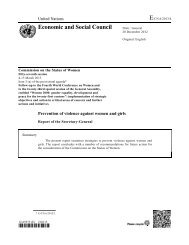
![IANSA [PDF, 2MB] - PeaceWomen](https://img.yumpu.com/25206379/1/190x123/iansa-pdf-2mb-peacewomen.jpg?quality=85)
![Commitments Sample [PDF, 93KB] - PeaceWomen](https://img.yumpu.com/25206331/1/190x245/commitments-sample-pdf-93kb-peacewomen.jpg?quality=85)


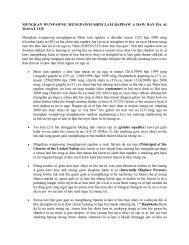
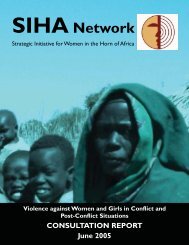

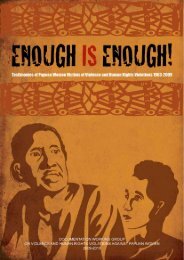

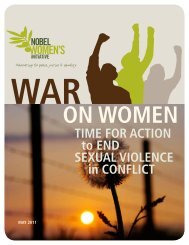
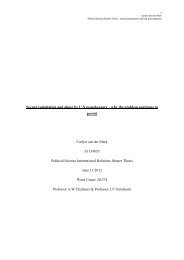

![A Toolkit for Advocacy and Action [PDF, 260KB] - Peace Women](https://img.yumpu.com/25205989/1/190x245/a-toolkit-for-advocacy-and-action-pdf-260kb-peace-women.jpg?quality=85)